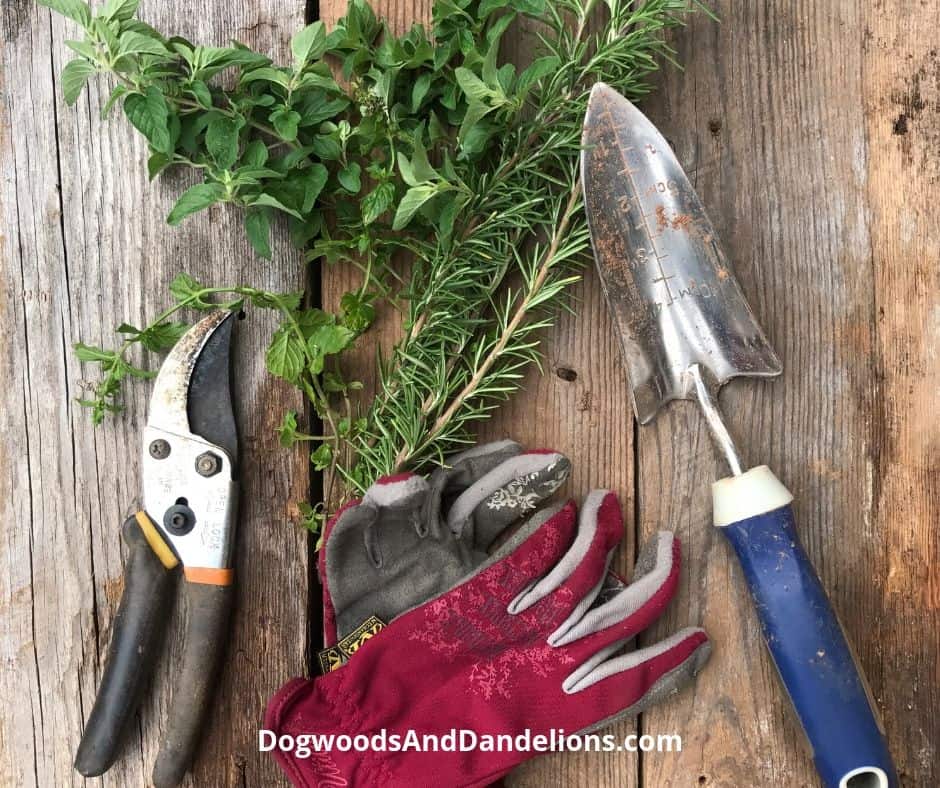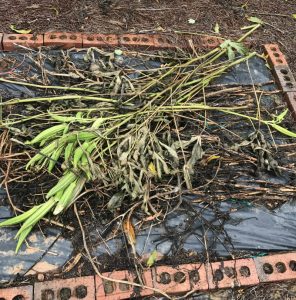How To Clean Up The Garden In The Fall
Inside: There are quite a few chores that need to be done before putting the garden to bed for the winter. I discuss several ways to clean up the garden in the fall so that you are ready to jump in and plant in the spring.

Affiliate Disclosure: Please note that some of the links in this article may be affiliate links and I may receive a small commission if you purchase something through a link. It will not change your cost. As an Amazon Associate, I earn from qualifying purchases. For more information, see my disclosures page.)
Clean Up Plant Debris
One of the first things that needs to be done during your fall garden cleanup is to remove any plant material from old plants so that it doesn’t give insects a place to hang out all winter. Squash bugs will hang out for a long time on squash vines and zucchini plants that are dead. So will many other insects.
Pests will also overwinter in mulch and leftover garden plants so they will be more prevalent next year. If you remove their hiding places, they will be less likely to survive the winter.
Pull up all the old dead plants and add them to the compost bin if they are disease free. For diseased plants, it is best to dispose of them in the trash.
Next, take down any cages, stakes, and trellises and clean off any leftover plants and vines hanging on them. Leaving plant matter on them can also harbor insects as well as give plant diseases an easy place to stay all winter.
Would you like to grow a garden this fall? Get your FREE fall vegetable planting guide that tells you exactly what to plant and when to plant your garden for a fall harvest.
Empty and remove any pots to keep mice from building a cozy nest in your garden. Store them out of the sun, preferably away from freezing temperatures as well. They will last longer if you store them somewhere besides the garden.
Remove or drain any water hoses, soaker hoses, and sprinklers in your garden. If you forget to do this, they will likely freeze during the winter and the freezing and thawing isn’t good for them.
Hoses and sprinklers will also last longer if they aren’t exposed to the sun every day. If possible, store them in an outdoor building or a garage instead of the garden.
Another thing to do to clean up the garden is to wash off any gardening tools such as trowels and rakes. This is a good time to fix or replace any broken ones so that they will be ready to use in the spring.
Many people also coat the tools with linseed oil. (For more information on how to use linseed oil, check out this article. You can purchase linseed oil here.)
Make a note of any new tools you need to purchase for next year. Sometimes you can even find them on sale this time of year. I know I always have to purchase at least one new pair of gardening gloves each year.
Plant a Cover Crop
The fall is also the perfect time to plant cover crops. They can be planted up to 4 weeks before your first frost. (Don’t know when your first frost is likely to be? Plug your zip code in here and you will find that date as well as some other helpful dates.)
Cover crops are the best way to keep the soil from washing out of your garden beds over the winter. They are also a great way to add organic matter and nutrients, especially nitrogen, back to the garden soil. For more information on cover crops check out this article from Modern Farmer.
Rake Fall Leaves
Fall is also the best time to rake leaves to add to your garden beds. However, I prefer to wait until early spring to add the leaves to my garden.
Putting the leaf litter down in the fall gives insects and rodents a cozy place to hang out all winter. Bag up the leaves or add them to your compost and you can add the dead leaves to the garden later.
Make Garden Notes
If you haven’t done so already, this is also a good time to make some notes on what crops did well in your garden and what did not. Make a note of the varieties you enjoyed and which ones you wouldn’t plant again.
You can also include information about how many plants of each crop you need so you don’t over/under plant next year. You want to do this now while your current garden is on your mind because when the seed catalogs come in the winter, every single variety of every single crop will look good!
Would you like to grow a garden this fall? Get your FREE fall gardening guide that tells you exactly what to plant and when to plant your garden for a fall harvest.
Prepare For Next Year

Fall is also a good time to go through your seed packets. Unless you have a HUGE garden, you probably have leftover seeds of many vegetables. Look through the seeds with your notes in mind.
Did you love a certain variety of cherry tomato plants? Make sure it is listed in your garden notes so you can plant it again.
Did you despise that variety of Brussels sprouts you planted? Throw away (or give away) the remaining seeds. There is no need to waste time and effort trying it again.
While cleaning up your garden, it is also a good idea to begin thinking about the next garden season. You certainly don’t need to plan out every detail (yet) but it is always a good idea to practice crop rotation by planting a different crop in the place you planted your tomatoes last year.
If you start thinking about it now, you can decide what soil amendments you might want to add. For instance, I clean out our chicken coop every fall and use it on my empty garden beds.
However, I don’t like to plant root vegetables in these beds for at least a year. If I know where I’m going to plant my carrots and lettuce next year then I use my regular compost of kitchen scraps on the carrots and lettuce and save my chicken manure for my beds with tomatoes and peppers.
Add New Garden Beds
Fall is a great time to think about adding new garden beds as well. If you plan on doing that, you can cover the area with black plastic or cardboard to smother the weeds.
Come Spring, the grass will be dead and the ground will usually be loose and easy to plant. For more information about using black plastic in the garden, check out my two-part series here and here.
Doing these tasks at the end of the season will give you a head start on next year’s growing season and make the following spring garden so much easier to work in. Do you do anything special to prepare your garden for winter? When do you plant your first crop in the spring?

For Further Reading
- Ways to grow vegetables during the winter
- How to start a backyard compost pile
- Start a lasagna garden that will be ready to plant in the spring

Meet Julie
I’m a farm girl born and bred in North Carolina. I’ve been growing a vegetable garden for over 20 years (and helping my Mom grow hers even longer). I’ve been raising chickens in my bathtub and backyard for 12+ years. I believe that homegrown food can be made simple. Let’s get started.



